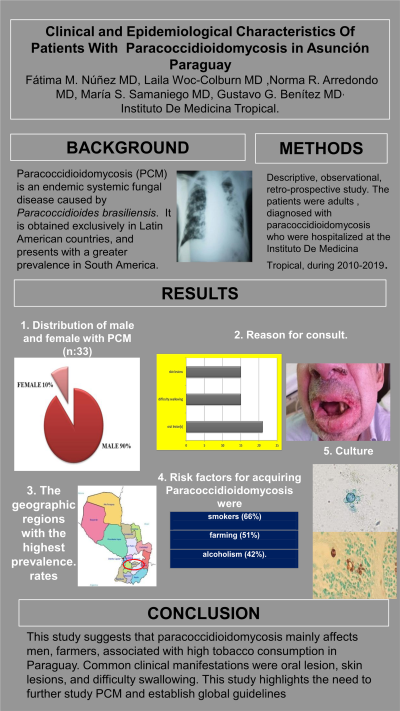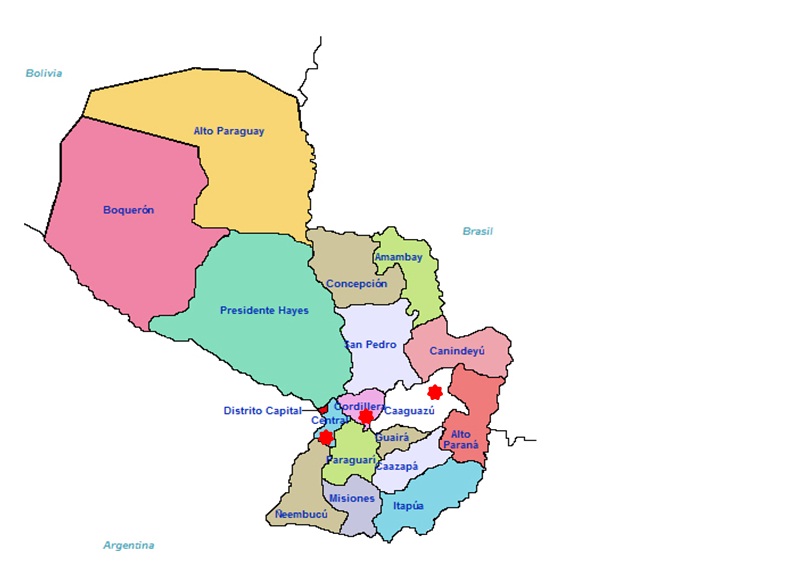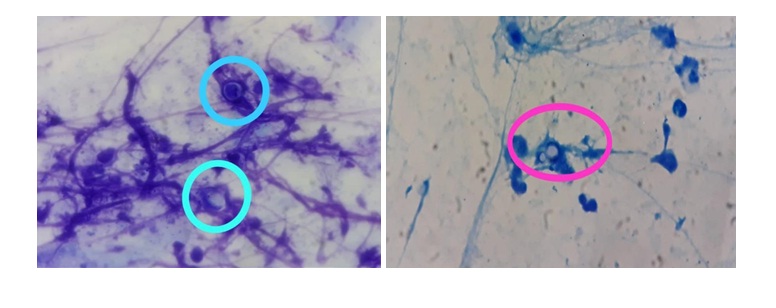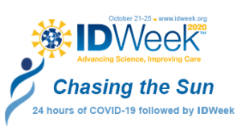Category: Medical Mycology
Poster Session: Medical Mycology
1155 - Clinical and Epidemiological Characteristics of Patients with Paracoccidioidomycosis in Asuncion Paraguay


Fátima M. Núñez
Doctor in Medicine
Instituto De Medicina Tropical, Universidad Católica “Nuestra Señora de la Asunción” Asunción, Paraguay
Asunción, Asuncion, ParaguayDisclosure: I do not have any relevant financial / non-financial relationships with any proprietary interests.
- LW
Laila Woc-Colburn
Doctor in Medicine
Division of Infectious Diseases, Department of Medicine, Emory University School of Medicine, Atlanta, GA National School of Tropical Medicine, Baylor College of Medicine, Houston, TX
Houston, TexasDisclosure: I do not have any relevant financial / non-financial relationships with any proprietary interests.
- NA
Norma Arredondo
Doctor in Medicine
Instituto De Medicina Tropical, Universidad Católica “Nuestra Señora de la Asunción” Asunción, Paraguay
Concepción, Concepcion, ParaguayDisclosure: I do not have any relevant financial / non-financial relationships with any proprietary interests.
- MS
Maria S. Samaniego
Doctor in Medicine
Helios salud
Lambaré, Central, ParaguayDisclosure: I do not have any relevant financial / non-financial relationships with any proprietary interests.
- GB
Gustavo G. Benitez
Doctor in Medicine
Instituto De Medicina Tropical, Universidad Católica “Nuestra Señora de la Asunción” Asunción, Paraguay
San Lorenzo, Central, ParaguayDisclosure: I do not have any relevant financial / non-financial relationships with any proprietary interests.
Presenting Author(s)
Co-Author(s)
Background: Paracoccidioidomycosis (PCM) is an endemic systemic fungal disease caused by Paracoccidioides brasiliensis. It is obtained exclusively in Latin American countries, and presents with a greater prevalence in South America. It is acquired through inhalation and spreads by lympho-hematogenous dissemination. Once the fungus has established itself in the body, it can affect any organ or tissue, but most commonly the skin, mucous membranes and lungs. It is a neglected disease, without mandatory notification, its impact is unknown.
Methods:
Descriptive, observational, retro-prospective study with analytical components, The patients were adults ( >18 years), diagnosed with paracoccidioidomycosis who were hospitalized at the Instituto De Medicina Tropical Asunción-Paraguay during 2010-2019.
Results:
There were 33 patients included in this study. Most patients were male (90%) and 10% were female, the mean age of 48. The main reason for consult was: oral lesion(s) (21%), difficulty swallowing (15%), and skin lesions (15%). The geographic regions with the highest prevalence rates (Fig1) were: Central, Cordillera and Caaguazú. The major risk factors for acquiring Paracoccidioidomycosis were farming (51%), smokers (66%) and alcoholism (42%). Only one patient was co-infected with HIV. The diagnosis was made either by culture or by biopsy results (Fig 2). All the patients were started on treatment with amphotericin B deoxycholate, with an average dose of 1,020 mg for induction and continued maintenance treatment with imidazoles. The mortality rate was 9.09%. The outpatient clinic follow up was low at 15% and 12 patients (80%) were treated successfully.Figure 1: Paraguay Coutnry Map showing the most affected areas with Paracoccidioidomycosis. Figure 2: Culture result.
Figure 2: Culture result.
Conclusion:
This study suggests that paracoccidioidomycosis mainly affects men, farmers, associated with high tobacco consumption in Paraguay. Common clinical manifestations were oral lesion, skin lesions, and difficulty swallowing. There are no current IDSA guidelines for treatment thus we use the national Paraguayan treatment guidelines. This study highlights the need to further study PCM and establish global guidelines.

